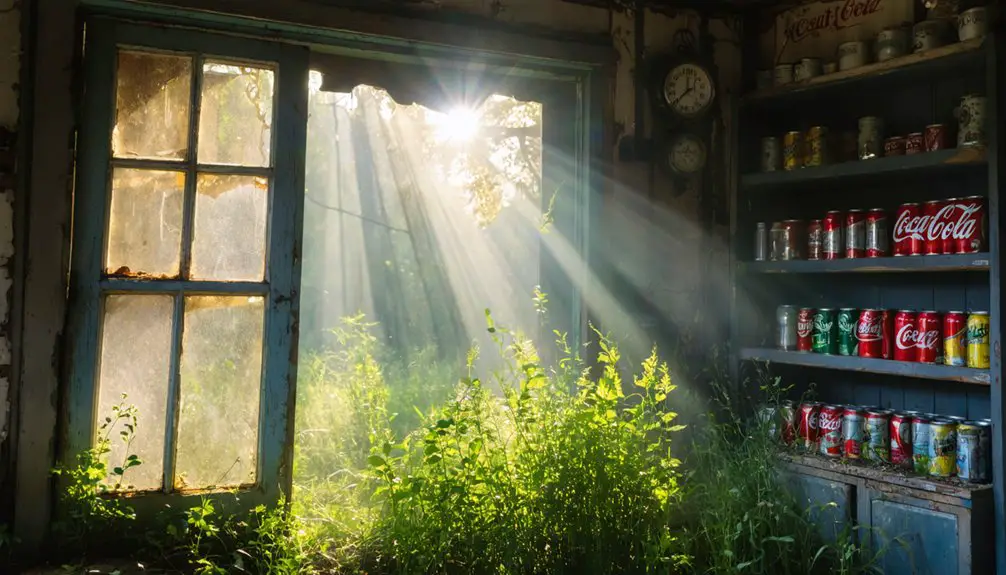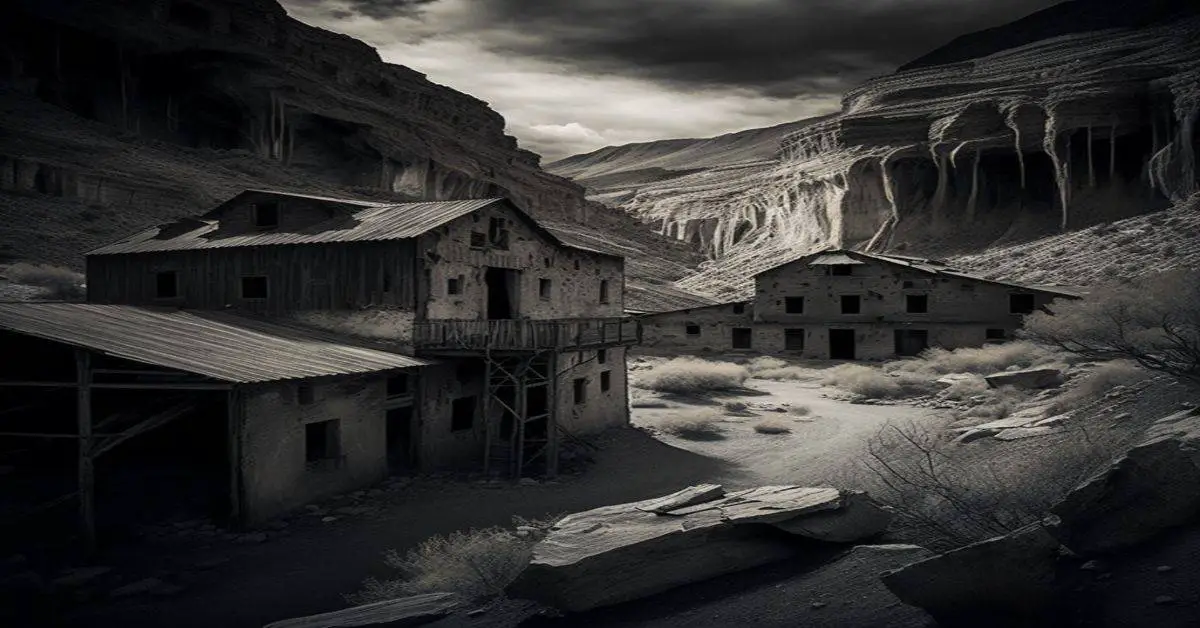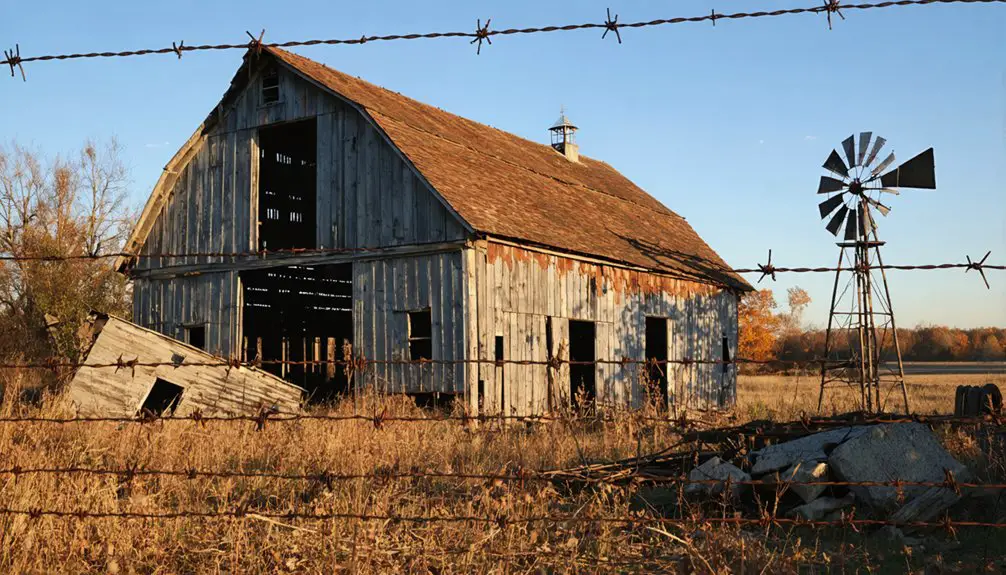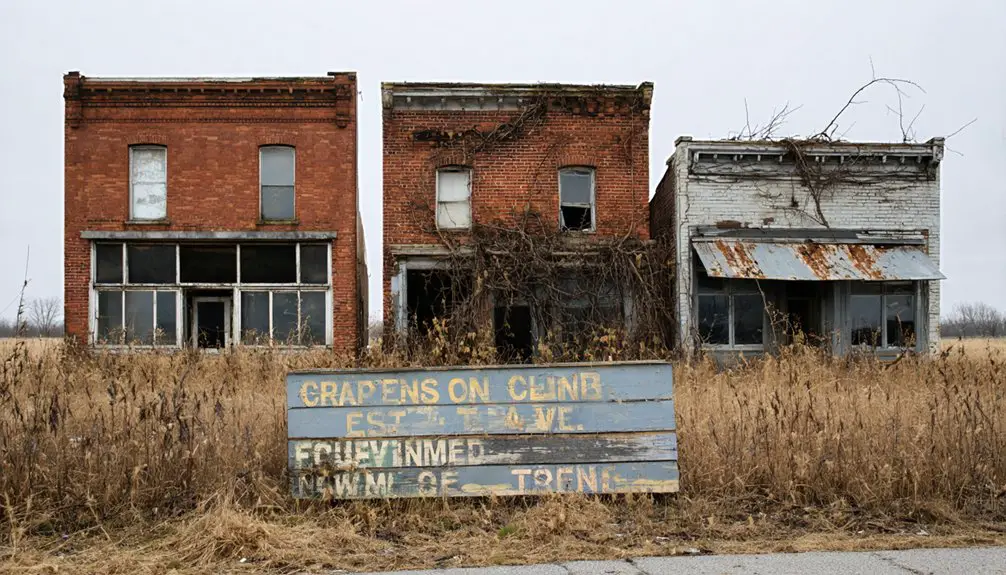You’ll discover Rumley’s remarkable story as a thriving biracial community founded in 1837 along an ancient Native American trail in Ohio. The settlement grew to 500 residents, with African American entrepreneurs like the Goings brothers establishing successful businesses alongside white neighbors. The town served as an Underground Railroad stop and featured integrated churches, schools, and venues. Though it declined by the early 1900s, Rumley’s legacy of racial harmony holds profound historical significance.
Key Takeaways
- Rumley was a thriving 19th-century integrated community in Ohio that declined into a ghost town by the Great Depression era.
- The town’s population peaked at 500 residents, with African Americans comprising half of Van Buren Township’s population.
- Economic decline began when Rumley was bypassed by major railroad lines, limiting its growth potential and commercial opportunities.
- Agricultural mechanization in the 1870s-1880s reduced labor needs, contributing to population loss and abandoned buildings.
- Original structures included brick buildings, churches, and businesses built by both black and white settlers, now largely abandoned.
Early Settlement and Founding Years
While several pioneer settlements dotted the Ohio landscape in the 1830s, Rumley emerged as a unique community when Amos Evans established the first log cabin, general store, and tavern in the area.
In 1830s Ohio, Rumley stood out among frontier towns after Amos Evans built its first structures and businesses.
The village’s official founding on June 14, 1837, marked the beginning of significant demographic shifts as free black settlers, including the influential Goings brothers, purchased 400 acres for development. The Goings brothers quickly became prominent business leaders, establishing a successful brick manufacturing operation.
You’ll find that founding challenges emerged when approximately 385 emancipated slaves from John Randolph’s Virginia plantation sought refuge in Rumley. Despite limited resources and legal hurdles in proving their free status, many persevered.
The town’s strategic location on an old Native American trail attracted diverse settlers, and by the mid-1800s, Rumley’s population reached 500, with residents living both in town and along its outskirts. The settlement became an important stagecoach stop along routes that served the Underground Railroad.
The Rise of Black Enterprise
The rise of black enterprise in Rumley began with the pioneering efforts of Joel and Wesley Goings, who in 1830 purchased 400 acres near the settlement. Their bold move laid the foundation for black entrepreneurship in the region, as they established multiple successful ventures including a hotel, livery stable, and brick manufacturing operation.
You’ll find that Rumley’s black business owners achieved remarkable success by providing essential services to both black and white residents. Their enterprises, strategically located along an old Indian trail, fostered community empowerment through economic self-sufficiency. Located about an hour from Columbus, the area attracted entrepreneurs seeking opportunities away from more restrictive urban environments. By 1846, the thriving community had grown to include over 7,000 acres of developed land.
Black families combined agricultural pursuits with diverse business ventures, matching their white neighbors in prosperity and social standing. By the mid-19th century, Rumley’s African American entrepreneurs had proven that success was possible despite widespread racial discrimination elsewhere.
Life Along the Indian Trail
Located strategically along an ancient Native American pathway, Rumley emerged as an essential stop on the stagecoach route connecting Piqua and Lima.
You’ll find that these Indian trails weren’t just travel routes – they were lifelines of cultural exchange that shaped the region’s social dynamics.
Following natural land contours, these paths connected crucial hunting grounds, trading posts, and settlements that sustained both native tribes and early settlers. The Great Trail served as one of the most significant pathways through the region, used extensively by the Wyandot, Mingo, and Delaware tribes. Early travelers through Harrison County often used these trails to navigate past the Standing Stone pillars that served as natural landmarks.
Notable Families and Community Leaders
Among Rumley’s most influential families, Joel and Wesley Goings established an impressive business empire that included a livery stable, hotel, and brick manufacturing operation after purchasing 400 acres in 1830 as free Black men.
You’ll find the Goings brothers were among Ohio’s earliest Black property owners, challenging racial norms while building substantial wealth and status in the community.
Their success fostered religious leadership and social advancement, contributing to Rumley’s reputation as an integrated town where Black citizens achieved remarkable equality with their white neighbors in 19th century rural Ohio.
Like the freed slaves who established East Wren in 1837, the Goings family represented a groundbreaking example of Black landowners and entrepreneurs in early Ohio.
Goings Family Business Empire
Pioneering entrepreneurs Joel and Wesley Goings established Rumley’s first black-owned business empire in 1830, beginning with their purchase of 400 acres of fertile Ohio land.
Their entrepreneurial spirit drove them to launch essential Goings enterprises including a brick manufacturing operation, livery stable, and hotel. These businesses greatly boosted local infrastructure while creating jobs for both black and white residents.
You’ll find their economic independence grew as they expanded their landholdings across Shelby County.
The Goings enterprises’ community impact reached far beyond mere commerce – they helped establish Rumley as a place where racial equality flourished.
Their business legacy as one of western Ohio’s earliest sustained black-owned commercial ventures challenged social norms and created lasting historical importance in the region’s development.
Early Black Property Owners
The landscape of early Rumley was transformed by influential black property owners who helped establish the town’s unique character of racial equality and economic prosperity. Joel and Wesley Goings, freed black men from Virginia, led this transformation through their strategic land acquisition of 400 acres in 1830, before Rumley’s official platting. Their success inspired other black families, like the Randolphs, to put down roots in the area.
You’ll find that these pioneering landowners weren’t just farmers – they were entrepreneurs and community leaders. The Goings brothers operated multiple businesses, including a hotel and brick manufacturing facility, while others like Clem Clay combined skilled trades with agriculture. Some residents were among the 383 freed slaves who made the arduous journey from Virginia to Ohio in 1846.
This economic diversity strengthened community resilience, helping black residents achieve remarkable prosperity and equal social standing in Van Buren Township.
Community Religious Leadership
Religious institutions formed the bedrock of Rumley’s social fabric, with three churches anchoring the community’s spiritual and cultural life during its peak.
You’ll find the Baptist Church and Temple of Rumley Church still standing today, proof of their enduring significance in fostering community cohesion among African American settlers.
The Goings family, particularly Joel and Wesley, exemplified how religious and civic leadership often intertwined. Over five hundred residents populated the general vicinity, making religious institutions vital centers for the growing community.
During regular religious gatherings, respected elders guided both moral and social affairs, while churches served multiple roles beyond worship – hosting educational programs, community meetings, and social events.
These institutions proved especially essential for emancipated slaves and new settlers, promoting equality and resilience while maintaining cultural identity through structured religious practice and community organization.
A Hub of Racial Integration
You’ll find remarkable evidence of racial integration in Rumley through the entrepreneurial success of the Goings brothers, who owned multiple thriving businesses including a hotel, livery stable, and brick manufacturing plant.
The village’s African American residents, who made up half of Van Buren Township’s population by the mid-19th century, participated actively in commerce and agriculture alongside their white neighbors as equals.
Rumley’s harmonious community life featured shared churches and schools, demonstrating an unusual level of social and cultural integration for the era.
Early Black Business Success
Pioneering African American entrepreneurs Joel and Wesley Goings established Rumley’s foundation for racial integration in 1830 when they purchased 400 acres of land and launched several successful businesses.
Their entrepreneurial spirit led them to build a diverse portfolio including a livery stable, hotel, and brick manufacturing operation. You’ll find that these ventures attracted both black and white customers, creating an economic ecosystem where racial barriers dissolved through commerce.
The Goings brothers’ economic resilience extended beyond agriculture, demonstrating that African Americans could thrive in multiple industries. Many early residents were among Randolph’s freed slaves, who found opportunities for advancement in this welcoming community. Their success challenged prevailing stereotypes, as contemporary accounts noted black residents’ equality in intelligence and character to their white neighbors.
This business acumen created lasting social capital, establishing Rumley as a unique example of racial cooperation decades before the civil rights movement.
Harmonious Community Life
While many communities in 1830s Ohio remained segregated, Rumley emerged as a remarkable example of racial integration, with approximately 400 African Americans comprising half of Van Buren Township’s population.
You’d find Black and white families attending the same churches, their children learning side by side in integrated schools, and neighbors of both races participating together in community events.
Social organizations fostered deep bonds across racial lines, creating a uniquely harmonious atmosphere that defied the era’s typical racial divisions.
Religious institutions reinforced shared moral values, while entertainment venues welcomed everyone equally.
This progressive village served as a hub where agricultural and commercial activities brought people together, demonstrating that peaceful coexistence wasn’t just possible – it was thriving in rural 19th-century Ohio.
Economic Growth and Development

During its promising early years, Rumley emerged as a diverse economic hub thanks to the entrepreneurial spirit of its founding settlers. You’d find economic opportunities through farming, livestock operations, and various family-run businesses.
The Goings brothers, freed Black entrepreneurs, established multiple successful ventures including:
- A thriving brick manufacturing plant
- A bustling livery stable
- A welcoming hotel operation
- A pioneering 400-acre land development
Agricultural challenges emerged in the 1870s as new machinery reduced labor needs, prompting some residents to seek work elsewhere.
While SR 29 and the Great Miami River provided some transport advantages, the lack of direct railroad access severely limited Rumley’s growth potential. The town’s distance from the Chesapeake & Ohio rail line, five miles away, ultimately constrained its industrial development and commercial expansion.
Decline and Transformation
As Rumley entered the latter half of the 19th century, a series of interconnected challenges triggered its gradual transformation from a thriving settlement into a semi-ghost town.
The town’s population shifts began when racial tensions erupted after 385 emancipated slaves sought settlement, leading many residents to leave. Social dynamics further deteriorated during the Civil War and Reconstruction periods.
You’ll find that agricultural mechanization in the 1870s and 1880s dealt another blow, reducing labor needs and forcing small farmers to seek opportunities elsewhere.
The town’s isolation from major railroad lines crippled its economic potential, while neighboring communities flourished.
When the Great Depression struck in the 1930s, it delivered the final blow, leaving only a handful of residents and abandoned structures as evidence of Rumley’s once-promising future.
Architecture and Historic Structures
The architectural legacy of Rumley paints a vivid picture of its frontier origins and brief prosperity. The town’s architectural styles evolved from Colonel Amos Evans’ initial log cabin to more sophisticated brick structures, showcasing the settlement’s growth.
From humble frontier beginnings to refined brick buildings, Rumley’s architecture tells the story of a settlement’s fleeting success.
You’ll find evidence of diverse construction techniques, from early wood-frame houses to locally produced brick buildings, highlighting the town’s economic aspirations.
- The Goings brothers’ enterprises anchored the town with a hotel, livery stable, and essential brick manufacturing operation.
- A multi-story brick ruin stands as proof of the quality of local masonry, with its sturdy corner supports still intact.
- The village’s commercial hub centered around the intersection of Hardin-Wapokeneta and Blanke Roads.
- Abandoned farm structures and houses scatter the landscape, reflecting 19th-century rural Ohio building patterns.
Legacy in Ohio’s Black History
Founded in 1837, Rumley emerged as a remarkable beacon of racial integration and African American achievement in antebellum Ohio.
You’ll find a rich cultural heritage in this settlement where the Goings brothers established themselves as pioneering black entrepreneurs, operating multiple successful businesses. The community exemplified social justice through its integrated daily life, with black residents achieving economic parity and respect alongside their white neighbors.
Through its role as a haven for freed slaves and its connections to Virginia’s emancipation movements, Rumley contributed greatly to Ohio’s network of free black settlements.
While the original community dispersed after 1870, you can still trace its enduring legacy through sites like the Temple of Rumley Church and African Jackson Cemetery, which stand as evidence to this unique chapter in Ohio’s black history.
Frequently Asked Questions
What Caused the Sudden Decline in Rumley’s Population After Its Peak?
You’ll find economic decline drove population migration, as racial tensions, agricultural mechanization, poor railroad access, and the Great Depression’s devastating impact forced residents to seek opportunities elsewhere.
Are There Any Remaining Descendants of Original Rumley Families Still Living Nearby?
Like scattered seeds in the wind, your family connections to original settlers may exist, but local history shows most descendants have dispersed throughout Shelby County rather than staying directly nearby.
What Role Did Rumley Play in the Underground Railroad Movement?
You’ll discover Rumley’s historical significance as a strategic Underground Railroad station, where brave conductors helped freedom seekers navigate dangerous border regions, providing essential safe houses along Ohio’s secretive northern escape routes.
Were There Any Major Natural Disasters That Affected Rumley’s Development?
You’ll find regional floods likely impacted Rumley’s early growth, though specific disaster records aren’t documented. Ohio’s devastating 1913 flood and other severe weather events probably affected the town’s development path.
Did Rumley Have Its Own Post Office or Train Station?
You’d find limited infrastructure there – a post office operated briefly from 1839-1842, but there’s no evidence of railroad connections. Most residents relied on nearby towns for postal services afterward.
References
- https://ohioghosttowns.org/shelby-county/
- https://www.shelbycountyhistory.org/schs/blackhistory/rumley.htm
- https://unearthedohio.com/2016/01/17/excursion-44-part-2-the-cold-never-bothered-me-anyway/
- https://ohioghosttowns.org/van-wert-county/
- https://www.hmdb.org/m.asp?m=227788
- https://en.wikipedia.org/wiki/Rumley
- https://www.ohiohistory.org/wp-content/uploads/2022/01/Civil_Rights_MPD.pdf
- https://bullrunnings.wordpress.com/2023/04/17/new-rumley-oh-birthplace-of-george-armstrong-custer/
- https://www.shelbycountyhistory.org/schs/blackhistory/bibliographbh.htm
- http://www.columbianacounty.org/history



